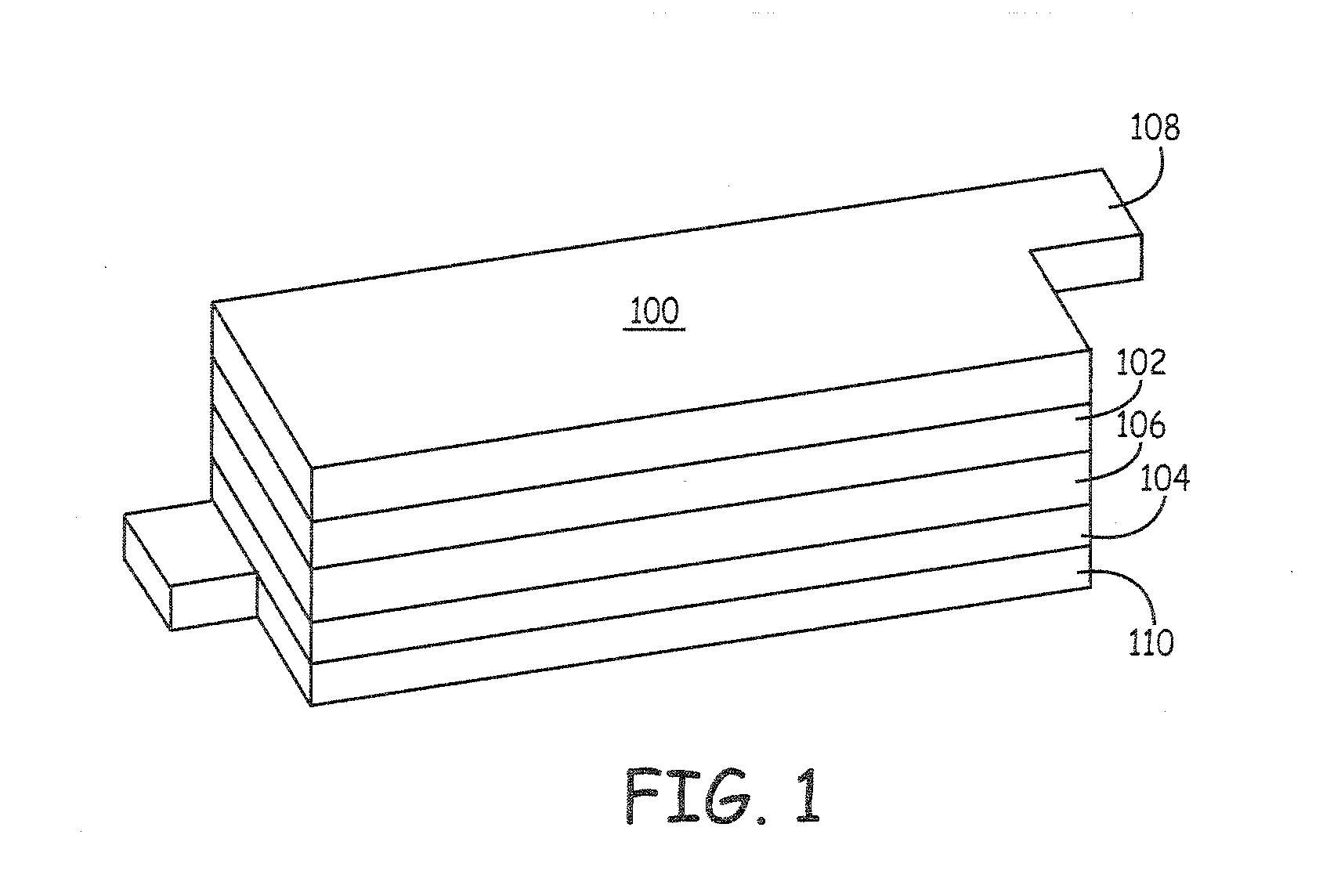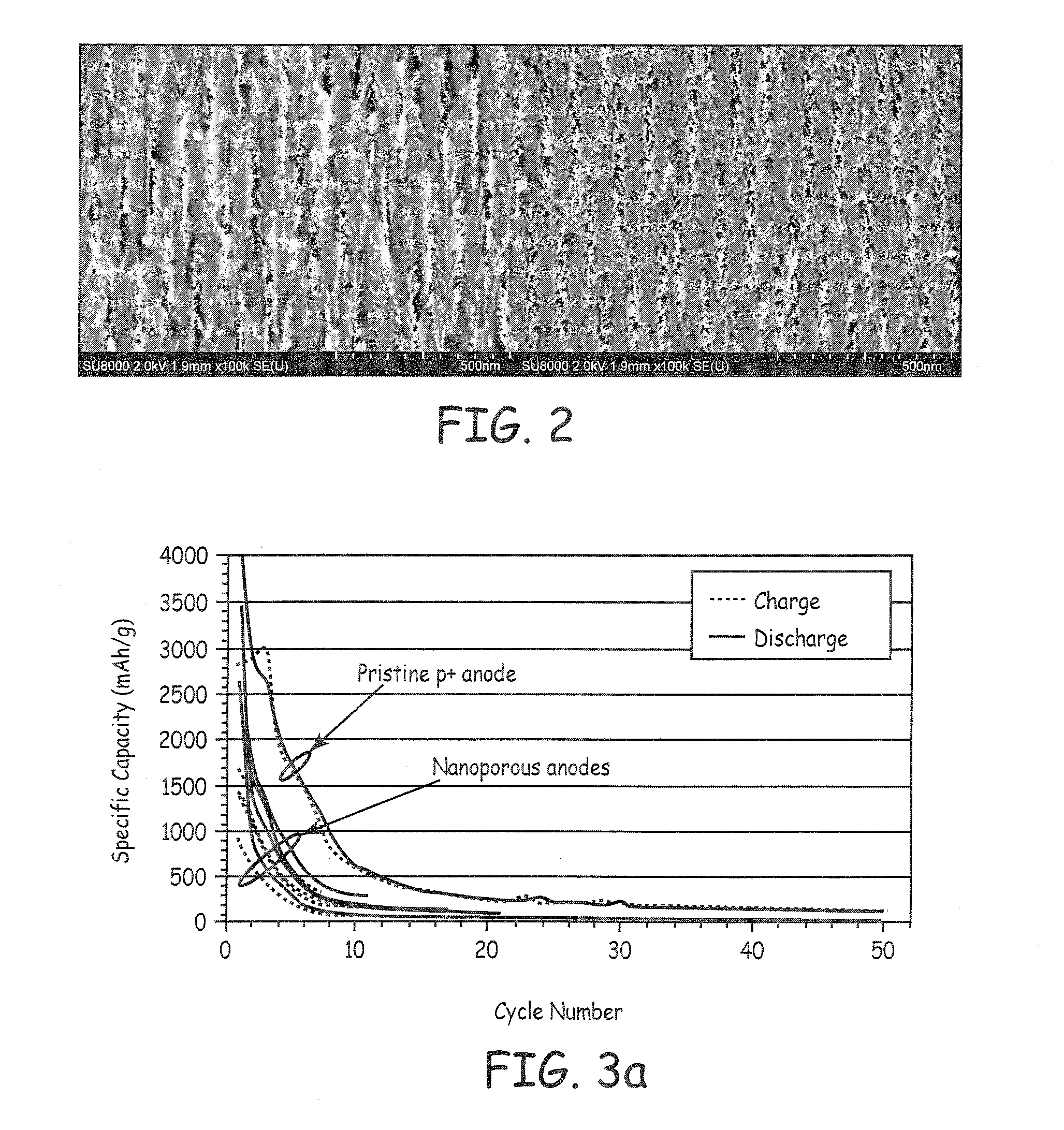High Capacity Anode Materials for Lithium Ion Batteries
a lithium ion battery, high-capacity technology, applied in the direction of batteries, cell components, electrochemical generators, etc., can solve the problems of reducing the cycling efficiency, affecting the structural integrity of the electrode, and unsuitable commercially for high-capacity negative electrode materials
- Summary
- Abstract
- Description
- Claims
- Application Information
AI Technical Summary
Problems solved by technology
Method used
Image
Examples
example 1
Cycling Performance: Negative Electrodes with Porous Silicon
[0122]This example demonstrates the cycling performance of coin-cell batteries fabricated from negative electrode active material comprising electrochemically produced porous silicon.
[0123]To demonstrate cycling performance, several coin cell batteries were formed as described above and varied with the composition of the silicon based electrode. With respect to the various silicon based electrodes, each electrode was formed from an active material that varied in nanostructure and / or non-active electrically conductive components. With respect to nanostructure, each silicon based electrode was formed from active material comprising either nanoporous p+ silicon or pristine p+ silicon, which was not porous. Nanoporous silicon was synthesized as described below, and the pristine p+ silicon was obtained using high energy mechanical milling of an equivalent p+ silicon wafer to form a powder that had an average particle size of abo...
example 2
Cycling Performance: Effect of Pyrolytic Carbon Coating Composition with NanoSilicon Particles
[0134]This example demonstrates the effect of variations in pyrolytic carbon coating formation on the performance nanoparticle silicon in coin cell batteries.
[0135]To demonstrate cycling performance, 3 coin cell batteries were formed as described above with a lithium foil negative electrode and various positive electrode compositions. Specifically, a battery was formed from a silicon-based active composition comprising nano-particle silicon having an average primary particle size of 50-100 nm from Nanostructured and Amorphous Materials, Inc. Two batteries were formed with negative electrodes comprising a silicon-based active composition having a pyrolytic carbon coating formed from carbonization of either glucose or citric acid at high temperatures to form a hard carbon coating.
[0136]The carbonization of glucose and citric acid was done with two separate approaches. Glucose was dissolved in...
example 3
Cycling Performance: Carbon-Silicon-Hard Carbon Composites
[0139]This example demonstrates the performance of coin cell batteries fabricated from electrodes formed from active materials comprising graphitic carbon-silicon-hard carbon coated composites (CSi-HC).
Formation of CSi-HC Electrodes
[0140]Composite precursor materials were prepared by ball milling. In particular, an appropriate amount of powdered silicon particles (Sigma-Aldrich, −325 mesh), surface modified graphite (A3-MagD), and polyacrylonitrile (Sigma-Aldrich) in n-methyl-2-pyrrolidone was added to a ball mill. A slurry was created by milling for 1 hr to 15 hr at a milling rate of 150 rpm-300 rpm. The milled slurry was then transferred to a vacuum oven and dried at 100° C. for 3 hours. The dried mixture was then transferred to a furnace and the polyacrylonitrile was carbonized in at 900° C. under a nitrogen atmosphere for 140 min to 240 min to form pyrolytic hard carbon. Carbon (graphite)-silicon-hard carbon composites us...
PUM
| Property | Measurement | Unit |
|---|---|---|
| density | aaaaa | aaaaa |
| thickness | aaaaa | aaaaa |
| length | aaaaa | aaaaa |
Abstract
Description
Claims
Application Information
 Login to View More
Login to View More - R&D
- Intellectual Property
- Life Sciences
- Materials
- Tech Scout
- Unparalleled Data Quality
- Higher Quality Content
- 60% Fewer Hallucinations
Browse by: Latest US Patents, China's latest patents, Technical Efficacy Thesaurus, Application Domain, Technology Topic, Popular Technical Reports.
© 2025 PatSnap. All rights reserved.Legal|Privacy policy|Modern Slavery Act Transparency Statement|Sitemap|About US| Contact US: help@patsnap.com



